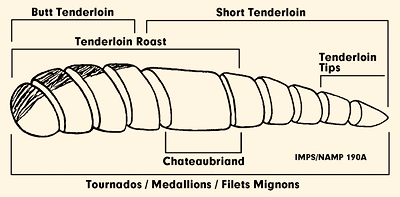 [Beef Filet; Filet de Boeuf (French)]
[Beef Filet; Filet de Boeuf (French)]
This is a "premium cut", from which restaurants derive many of their most profitable (and fancily named) dishes. It is taken from the loin area, inside the ribs and just below the spine near the aft end of the beef, just forward of the "round" (the beef's tush). This muscle is very lean, but gets less exercise than any other muscle in the beef, so it is naturally tender. It also has the least beefy flavor, making it suitable for showing off the chef's sauces.
The photo specimen is cut IMPS/NAMP #190A, full tenderloin with all fat and side muscle removed. Note the "wing", the crosswise piece at the right end (the iliacus muscle) is not included in the classic recipes but cut away for some other use. The thick end (to the right) is the aft end and called the "butt" end. This specimen was 25 inches long, 1-1/4 inches thick and up to 3-1/2 inches wide, not counting the "wing". It weighed 2.46 pounds, about average,
More on Cuts of Beef.
The ethnic markets I normally shop at sell tenderloin at the butcher's counter for around 2019 US $7.99 per pound, but the U.S. grown photo specimen was from the floor cases at an Asian market in Alhambra. It was still in the shrink wrap as shipped from the meat packer. The price was 2009 US $2.99 / pound, and the USDA grade was probably "Standard", since there was no visible fat in the meat and it was sold without a USDA grade. Flavor was quite good though, and the meat decently tender. Keep in mind the USDA grade indicates nothing more than the amount of fat marbled through the meat. Select and Standard are leaner and Prime is very fatty (only about 2% of American beef is fatty enough to rate Prime).
Which cut number you buy (see next section) depends on usage. Unfortunately your local market will not have their cuts conveniently identified by number, but you should be able to figure it out from the descriptions below.
The #189 will cut into steaks (#1189) with a surround of fat which you can trim to the thickness you desire. The #189A steaks (#1189A) will have very little fat, but more than the #1190, and will be a bit larger because the side muscle is still on. These two cuts are fine for simpler recipes. The #190/190A cuts are best for the more refined recipes and will have just about no external fat at all, but they will be smaller. These cuts are desired by fancy chefs so the fat doesn't interfere with the taste and texture of their sauces.
#189 needs all the external fat removed, but most of this usually
pulls off easily by hand. Then remove the "silver skin", the membrane
around part of the main muscle. I've found this is easy to pull off in
shreds once you cut it free at one end.
#189A has all fat removed but needs the silver skin removed.
#190 is the same as #189A except the side muscle (psoas minor,
parallel to the main psoas major) has been removed.
#190A has had both the side muscle and silver skin membrane
removed.
#191 is the Butt Tenderloin with fat, same condition as #189.
#191A is #191 but fat removed as for #189A.
#191B is #191A but with the silver skin removed.
#192 is the Short Tenderloin, fat on as for #189.
#192A is the Tenderloin Tips. The side muscle may or may not
be included.
 The standard American cuts are shown in the diagram. They are somewhat
variable, because the Chateaubriand section may be longer or shorter or
absent entirely, the entire thing can be cut into Tournedos (also called
Tournados or Medallions). Technically, Chateaubriand is a recipe for a
tenderloin roast, not a cut of meat. In restaurant practice any portion of
the tenderloin can be called "Tournedos".
The standard American cuts are shown in the diagram. They are somewhat
variable, because the Chateaubriand section may be longer or shorter or
absent entirely, the entire thing can be cut into Tournedos (also called
Tournados or Medallions). Technically, Chateaubriand is a recipe for a
tenderloin roast, not a cut of meat. In restaurant practice any portion of
the tenderloin can be called "Tournedos".
French practice is a bit more formal. While American butchers tend to call
the entire tenderloin "Filets Mignons", the French reserve
Filets Mignons for only a few slices at the small end of the filet de
boeuf. Beyond that you
have Tournedos, then Chateaubriand for the thicker center
section and finally Biftek at the tet de filet, the big
end.
Tenderloin should not be cooked beyond medium rare, or you're just wasting your money. If you want "well done", fry hamburgers.
ab_tloinz 090913 - www.clovegarden.com